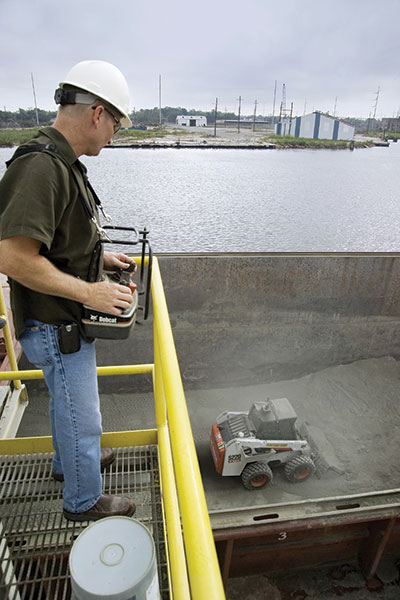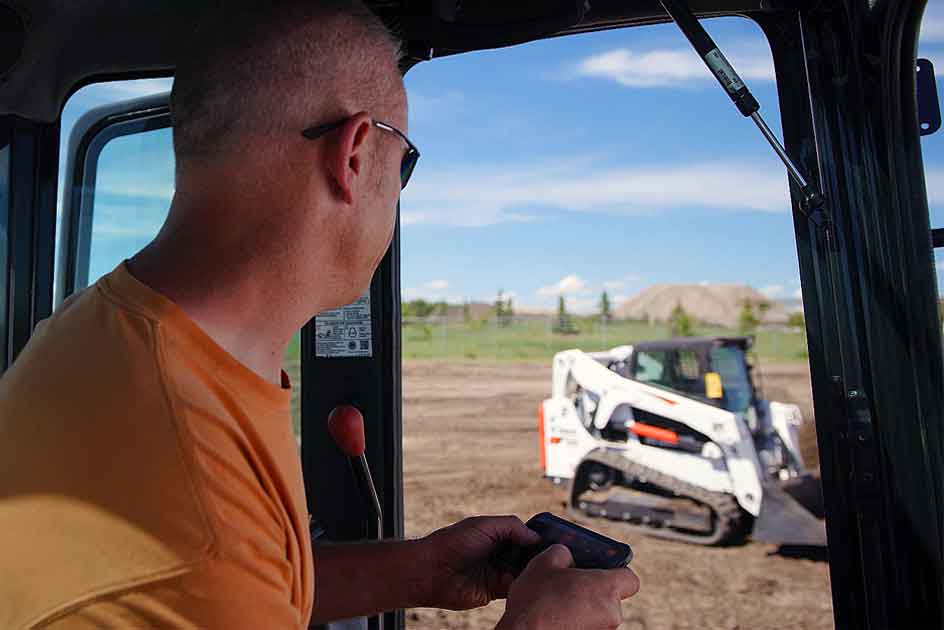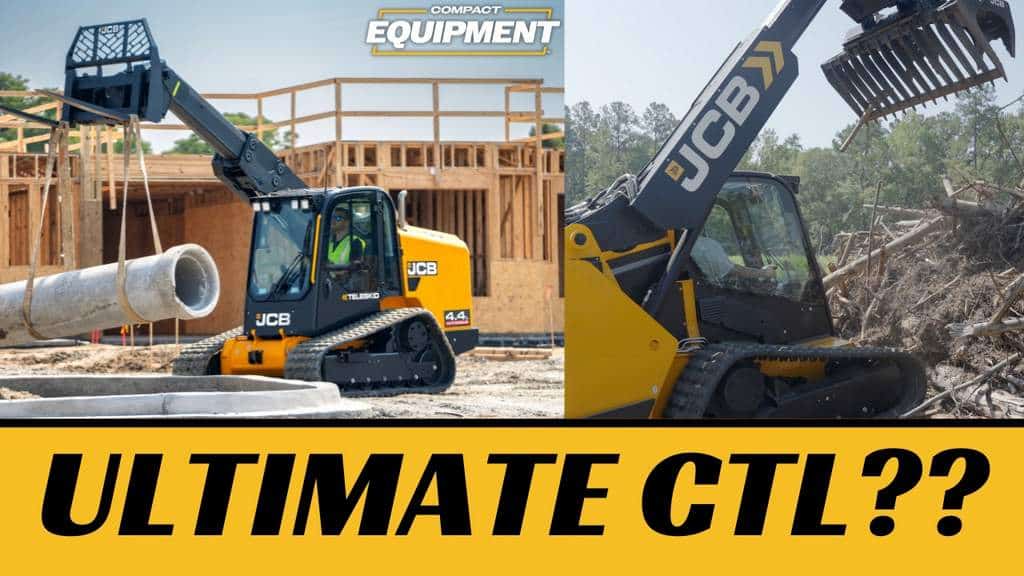Control Your Skid Steer or Track Loader Via Remote Control
Remote-controlled track loaders and skid steers are not as sophisticated as Google’s driverless cars, but their seats are just as empty when the machines are operating. That is the whole point — getting compact equipment operators out of the cab so they can work more safely and accomplish some tasks more easily. These are the reasons why mining operations have relied on remote-controlled digging machines for years. More recently, some full-sized quarry equipment has been modified to run remotely to scoop up aggregate in precarious locations. It’s no wonder then that more and more compact and mini loaders are being operated by walking-around joystick jockeys.
“This may be considered a niche market product compared to the overall volume of skid steer loaders on the market,” says Jeff Griffith, senior market professional at Caterpillar. “However, more and more applications are being identified that benefit removing an operator from hazardous conditions and environmentally uncomfortable conditions that warrant operating a machine remotely.”
Operator safety and comfort are indeed primary reasons for the surge of remote technology on compact loaders. For example, removing spillage under overhead conveyors poses risks to an operator unless the operator is standing a safe distance away with his controlling transmitter suspended from shoulder straps and resting on his stomach like a ballgame vendor’s tray.
Griffith says working under conveyors is one of the two most common applications of remote-controlled loaders. The other application he cites is, of all things, stevedoring — the loading and unloading of cargo from the holds of ships. Working in the belly of a vessel can be precarious because of ventilation concerns and materials dropping from above. But any environmentally marginal task — one that is deafening, extremely dusty or clouded with toxic inhalants — is perfect for a remotely controlled loader. Grinding stumps or concrete, for example, or running an asphalt planer are situations where an equipment operator is better off a short distance away.

Bobcat’s remote system works on any of its compact loaders with Selectable Joystick Controls, which covers models going back 15 years.
In addition, some tool applications on compact loaders require the loader to be operated in reverse — opening a trench, for example. That leaves the loader operator in a poor position to keep an eye on his path of travel. Whereas when the remote operator is standing beside the loader, he can easily monitor both the trenching and the backward movement of the machine.
This outside perspective sometimes means one person can accomplish a task formerly requiring two — running a cold planer, for example, or a pavement saw. “Using either of these attachments often requires one person to guide and observe placement of the tool while the operator runs the attachment,” says Jason Archbold, marketing manager for Bobcat. “With the radio remote control system, a single operator can run the machine and observe the attachment at work.”
The remote system obviously is applicable to more tasks than simple bucket work. In fact, all hydraulic functions and machine-approved attachments are available to Bobcat remote controllers. “An operator can run the machine with all the same capabilities as if they are in the machine,” Archbold says.
A remote operator generally can perform close-tolerance tasks with the same dexterity as when seated in the cab. To a nimble-fingered operator, a joystick is a joystick. “The precise, smooth controllability of the machine provided by RemoteTask allows the operator to virtually mimic the feel of the controls from outside the cab,” says Griffith. “So, this provides a very broad spectrum of work tools that can be successfully operated on the machine.”
That doesn’t mean every tool is advantageously run remotely. While “virtually all” of Caterpillar’s 200 attachments for its compact loaders can be operated using RemoteTask technology, the backhoe attachment is one exception. The subtle hydraulic movements required in backhoeing and the preferred view from the driver’s seat override any advantage remote control might offer.
Remote operation is mastered quickly by experienced operators, the manufacturers say except for when a loader is moving toward the operator. In that circumstance, the directional command to the loader is effectively reversed — left being right and right being left. Adroit operators figure it out soon enough and adapt. All but the four smallest of Caterpillar’s D Series loaders can utilize its RemoteTask system. Bobcat’s system works on any of its compact loaders with Selectable Joystick Controls, which covers models going back 15 years. Archbold says the smaller and larger Bobcat models are most often remote-controlled. “The small frame models are used in tight and confined spaces, and the large frame machines are commonly used when moving materials in hazardous areas.”

Remote operators use the control transmitter above, suspended via shoulder straps, resting on their stomach like a ballgame vendor’s tray.
Radio remote transmitters work only when the machine is in line of sight and within a specified range. These limitations ensure that a driverless loader won’t gallivant around a corner unseen and unsupervised. The radio transmissions also are interrupted if an operator trips and falls or otherwise dramatically tilts his transmitter, which signals that a controller is not actively monitoring the machine. These safeguards along with emergency stop buttons protect both the machine and any workers in the immediate area.
The remote-control apparatus on Cat and Bobcat compact loaders can be quickly affixed to a machine and just as quickly transferred from one machine to another. With the apparatus in place, the flip of a switch is all that’s necessary to take control from a remote controller and give it to a seated operator, which makes the piece of equipment more versatile. When you combine that versatility with the fact that one operator sometimes can do the work of two employees and that remote operators are safely removed from toxic or noisome situations, it seems clear that remote-controlled compact equipment has a future in U.S. workplaces.
Giles Lambertson is a freelance writer for Compact Equipment.






Do they make this for case skid steers I’m paralyzed from my chest down and this would be handy to help me get back to working around our farm with out relying on someone else
We make a range of remote control systems for excavators loaders etc.
Check out our website http://www.remoquip.com and also many youtube videos
Regards.
Francis Dolan
I would love this for excavators or backhoes, digging around gas lines, fiber optic lines, water and sewer mains, without having to rely on someone guiding me..
in cab for everything, and out of it for the precise blind digging.
Where can I purchase a remote control for my bobcat?
Contact your local Bobcat dealer.
Please call me on your mote control unit that you sell for Bobcats I want to use it for a snowmobile engine 562 296 3030
Are there any remote controls for the new Kubota skid steer?
Kubota doesn’t make one, but there are aftermarket kits. Right now, Cat and Bobcat are also making remote control options on skid steers and track loaders.
who makes aftermarket kits for Kubota
I have a 2016 SVL 90 Kabota how much for remote for that unit